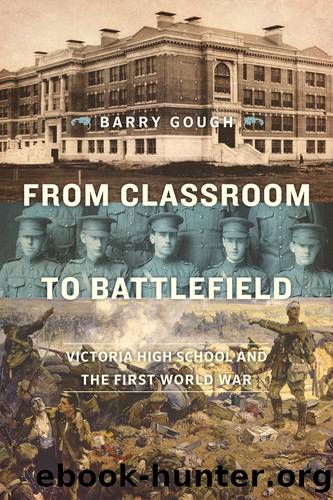From Classroom to Battlefield by Barry Gough

Author:Barry Gough
Language: eng
Format: epub
ISBN: 978-1-77203-006-8
Publisher: Heritage House
Published: 2014-10-31T16:00:00+00:00
Air power had been having a growing impact in the War, and it played a large role at Passchendaele. The Royal Flying Corps (RFC) waged a battle in the air against its German opposite, with marked success. The designs, engines, speeds, armament, and manoeuvrability of airplanes were changing rapidly. Pilots in the RFC saw themselves as the “knights of the air,” the gladiators, energetic and chivalrous, a special breed of warrior set apart by the prospects of war in the central blue, four miles above earth.
Victoria enjoyed a long-standing history of aviation, with the city’s first flights being made on Lansdowne Field in the 1910s. The excitement of war in the air spurred much interest. Small wonder that great Canadian airmen became pilots in the RFC. One-third of all pilots of that service in the Great War were from Canada. Men from Victoria High School, often enlisting first as privates in the CEF, made a successful transfer to the Royal Naval Air Service (RNAS) or the RFC, and then made notable contributions to the air war, some dying tragic deaths, others undertaking heroic assignments, still others completing their missions without incident. There was a good deal of low-level flying, when the enemy machine-gunners could see the faces of the attacking RFC pilots. Mechanical failures were common. Altogether the work was hazardous, the elements often difficult, and the equipment less than completely reliable. It was high-risk work, and it attracted some of the most daring types.
We go back to the previous year, 1916, to note the first of Victoria High School’s young men to die in one of the air units. On July 20, 1916, Flight Sub-Lieutenant Douglas Whittier, RNAS, born and educated in Victoria, son of Anson and Amelia Whittier of 1972 St. Ann Street, died age twenty-four. A member of 3 Wing awaiting orders to Luxeuil, France, he attempted a low-level loop in Bristol Scout C1245 near Manston, England, but his machine lost speed, twisted into a sideslip, and made a spiral nosedive to earth. The court of inquiry delivered a verdict of misadventure, for all the controls were found in good order. The verdict of the inquest reads: “This Officer was a good Pilot and his death is deeply felt amongst the Officers & Men of the Wing.” Arrangements were made to provide a gun carriage on loan from the Army, a band and a firing party for the funeral. He is remembered with honour in Minster (Thanet) Cemetery, Kent.32
Another of these knights of the air was Flight-Lieutenant George Robert “Robin” Gray, RNAS. He was the youngest of three Gray boys, all Victoria- born and graduates of the school, and the best known on account of the circumstances of his death. (The story of his eldest brother, Lieutenant Andrew Jack Gray, has been told in connection with events of early 1915.) Their father, Andrew Gray, born and raised in Scotland, was a mechanical engineer and owner of Marine Iron Works, Victoria.33 Their mother, Mary, was born in Scotland.
Download
This site does not store any files on its server. We only index and link to content provided by other sites. Please contact the content providers to delete copyright contents if any and email us, we'll remove relevant links or contents immediately.
| Africa | Americas |
| Arctic & Antarctica | Asia |
| Australia & Oceania | Europe |
| Middle East | Russia |
| United States | World |
| Ancient Civilizations | Military |
| Historical Study & Educational Resources |
Cat's cradle by Kurt Vonnegut(13866)
Pimp by Iceberg Slim(12931)
Underground: A Human History of the Worlds Beneath Our Feet by Will Hunt(11256)
4 3 2 1: A Novel by Paul Auster(11046)
The Radium Girls by Kate Moore(10907)
American History Stories, Volume III (Yesterday's Classics) by Pratt Mara L(4825)
Perfect Rhythm by Jae(4621)
Wiseguy by Nicholas Pileggi(4585)
The Fire Next Time by James Baldwin(4342)
Paper Towns by Green John(4169)
A Higher Loyalty: Truth, Lies, and Leadership by James Comey(4032)
Pale Blue Dot by Carl Sagan(4001)
The Mayflower and the Pilgrims' New World by Nathaniel Philbrick(3911)
The Doomsday Machine by Daniel Ellsberg(3730)
Too Much and Not the Mood by Durga Chew-Bose(3693)
Killers of the Flower Moon: The Osage Murders and the Birth of the FBI by David Grann(3608)
The Borden Murders by Sarah Miller(3590)
The Sympathizer by Viet Thanh Nguyen(3477)
Killing England by Bill O'Reilly(3454)
